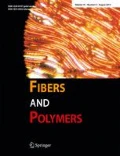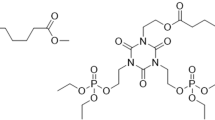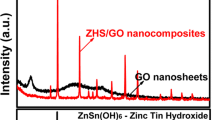Abstract
Plasticizers that enable flexible polyvinyl chloride (PVC) are usually combustible, restricting the application of PVC in fire-prone scenarios. In this context, intrinsically flame-retardant plasticizers displaying dual function continue to be the focus of intensive research. Despite their efficiency, the majority of these dual-functional plasticizers previously reported contain halogen elements, which, once ignited, emanate toxic and potentially carcinogenic substances, along with toxic gases and smoke, polluting the environment, damaging the biota, and threatening human health. Here, we report a strategy to obtain a halogen-free, intrinsically flame-retardant PVC bio-plasticizer that harnesses the phenolic hydroxyl of naturally occurring cardanol and covalent attachment of an organophosphate moiety. When combined with di-(2-ethylhexyl) phthalate (DOP), the organophosphate-containing cardanol is qualified as a co-plasticizer, while endowing the PVC materials with flame retardancy. Unlike inorganic flame-retardants, the engineered cardanol is compatible with PVC such that the mechanical properties of the PVC materials are not compromised. The rationale underlying the present effort may provide guidance for developing sustainable alternatives to halogen-containing plasticizers to address the sustainability challenge now confronting PVC industry.
Similar content being viewed by others
References
S. Y. Pan, D. L. Hou, G. F. Yang, Q. P. Xie, S. X. Yan, Q. Zeng, Z. H. Wang, Y. Chen, and H. J. Fan, J. Leather Sci. Eng., 1, 2 (2019).
M. Q. Wang, J. Yan, S. G. Du, J. S. Zhao, B. Wang, and J. Q. Ding, Fiber. Polym., 15, 1175 (2014).
S. Y. Pan, D. L. Hou, J. M. Chang, X. Zhou, S. H. Wang, S. X. Yan, Q. Zeng, Z. H. Wang, and Y. Chen, Green Chem., 23, 6430 (2019).
T. Y. Park and S. G. Lee, Fiber. Polym., 8, 620 (2007).
P. Y. Jia, M. Zhang, C. G. Liu, L. H. Hua, G. D. Feng, C. Y. Bo, and Y. H. Zhou, RSC Adv., 5, 41169 (2015).
H. D. Lu, L. Song, and Y. Hu, Polym. Adv. Technol., 22, 379 (2011).
F. C. Wang, J. Chromatogr. A, 886, 225 (2000).
G. E. Zaikov and S. M. Lomakin, J. Appl. Polym. Sci., 86, 2449 (2002).
I. D. Veen and J. D. Boer, Chemosphere, 88, 1119 (2012).
P. K. Zhang, Z. Y. Zhang, H. J. Fan, S. Q. Tian, Y. Chen, and J. Yan, RSC Adv., 6, 56610 (2016).
B. Zhang, Y. J. Jiang, and J. Han, Silicon, 10, 2845 (2018).
H. C. Erythropel, S. Shipley, A. Börmann, J. A. Nicell, M. Maric, and R. L. Leask, Polymers, 89, 18 (2016).
Y. Wang, M. M. Hou, Q. N. Zhang, X. W. Wu, H. X. Zhao, Q. Xie, and J. W. Chen, Environ. Sci. Technol., 51, 10991 (2017).
S. Y. Lu and I. Hamerton, Prog. Polym. Sci., 27, 1661 (2002).
C. Voirin, S. Caillol, N. V. Sadavarte, B. V. Tawade, B. Boutevin, and P. P. Wadgaonkar, Polym. Chem., 5, 3142 (2014).
A. Greco, D. Brunetti, G. Renna, G. Mele, and A. Maffezzoli, Polym. Degrad. Stab., 95, 2169 (2010).
P. Yang, J. Yan, H. Z. Sun, H. J. Fan, Y. Chen, F. Wang, and B. Shi, RSC Adv., 5, 16980 (2015).
P. K. Zhang, S. Q. Tian, H. J. Fan, Y. Chen, and J. Yan, Prog. Org. Coat., 89, 170 (2015).
B. I. Chaudhary, B. D. Nguyen, P. Smith, N. Sunday, M. Luong, and A. Zamanskiy, Polym. Eng. Sci., 55, 634 (2015).
Plastics-Determination of Migration of Plasticizers, ISO 177: 2016 (E).
Standard Test Method for Tensile Properties of Plastics, ASTM D638 (2014).
Standard Test Methods for Vulcanized Rubber and Thermoplastic Elastomers—Tension, ASTM D412 (2016).
Determination of Burning Behaviour by Oxygen Index, Chinese Standard GB/T 2406.1 (2008).
Y. J. Xu, J. Wang, Y. Tan, M. Qi, L. Chen, and Y. Z. Wang, Chem. Eng. J., 337, 30 (2018).
P. Svoboda, C. Zeng, H. Wang, L. J. Lee, and D. Tomasko, J. Appl. Polym. Sci., 85, 1562 (2002).
G. Camino, M. P. Luda, and L. Costa, Fire. Polym. II, 6, 77 (1995).
Acknowledgements
We gratefully acknowledge financial support of this work by National Key Research and Development Program of China (2017YFB0308600), National Natural Science Foundation of China (21878196), Fundamental Research Funds for the Central Universities, China (20826041C4159), and Sichuan University-Sichuan Jinlu contract (19H0266).
Author information
Authors and Affiliations
Corresponding author
Rights and permissions
About this article
Cite this article
Hou, D., Wang, S., Chang, J. et al. Cardanol with a Covalently Attached Organophosphate Moiety as a Halogen-Free, Intrinsically Flame-Retardant PVC Bio-Plasticizer. Fibers Polym 21, 1649–1656 (2020). https://doi.org/10.1007/s12221-020-9918-4
Received:
Revised:
Accepted:
Published:
Issue Date:
DOI: https://doi.org/10.1007/s12221-020-9918-4




